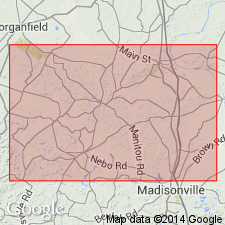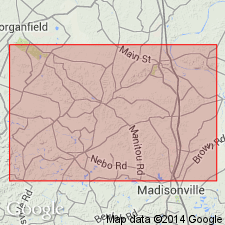
- Usage in publication:
-
- Graves Creek formation
- Modifications:
-
- Named
- Dominant lithology:
-
- Clay
- Sand
- Gravel
- AAPG geologic province:
-
- Illinois basin
Summary:
Name Graves Creek formation introduced in this report for fine or mucky clay, sand, and gravel, 100 to 175 ft thick in Webster Co., western KY. Underlies Recent alluvium and overlies Union formation (Pliocene). Assigned to Pleistocene.
Source: GNU records (USGS DDS-6; Reston GNULEX).

- Usage in publication:
-
- Graves Creek formation
- Modifications:
-
- Overview
- AAPG geologic province:
-
- Illinois basin
Summary:
The larger part of Graves Creek formation is believed to be older than Union formation, but it is probable that surface part may be contemporaneous with Union. On Graves Creek, in Webster Co., a well penetrates 104 ft of this clay without reaching its base. Age is Pleistocene.
Source: GNU records (USGS DDS-6; Reston GNULEX).
For more information, please contact Nancy Stamm, Geologic Names Committee Secretary.
Asterisk (*) indicates published by U.S. Geological Survey authors.
"No current usage" (†) implies that a name has been abandoned or has fallen into disuse. Former usage and, if known, replacement name given in parentheses ( ).
Slash (/) indicates name conflicts with nomenclatural guidelines (CSN, 1933; ACSN, 1961, 1970; NACSN, 1983, 2005, 2021). May be explained within brackets ([ ]).

